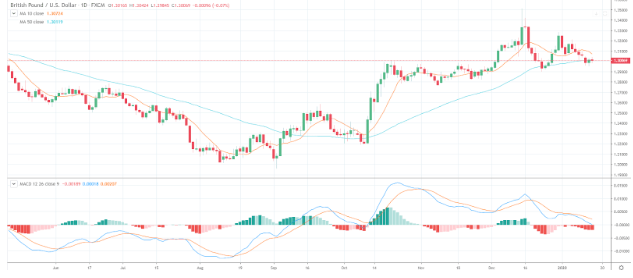The British pound has been trading defensively, as calls for the BoE to reduce interest rates continue to grow louder. The region is feeling the effects of lower inflation as well as declining growth as Brexit has taken its toll on the British economy. UK GDP, Industrial Production and Consumer prices all came in weaker than expected which has weighed on UK yields driving the interest differential away from the pound. The Chinese Yuan has been in a downtrend declining more than 4% since hitting a multi-year high of 7.17 in September of 2019.

Calls for a BoE to cut interest rates is gaining momentum. This is putting downward pressure on GBP/USD trading. While a final resolution on the UK EU relationship is still up in the air, there is less uncertainty about a sudden hard-Brexit. The short-sterling futures contracts now place approximately a one in five chance that the BoE will cut rates on their January 30 meeting compared to 5% at the beginning of 2019.
UK economic growth reported for November, along with Industrial production, as well as trade and construction output were broadly weaker than anticipated. Industrial production declined by 1.2% month over month compared to expectations which were for an unchanged reading. The trade balance came in at a surplus of 4-billion pounds compared to an expected -GBP2.5 billion deficits, while construction output rose.
More importantly, UK inflation is on the decline. Since the mandate of the BoE is to manage inflation, they might be forced into a position to cut rates as inflation diverges away from their target of 2% year over year annually. The UK December Consumer Price Index declined to a three-year low of 1.3% year over year compared to expectations that it would come in near 1.5%. This moves inflation further below the BOE’s 2% target.
The Chinese Yuan Rallies Ahead of Trade Agreement
The Chinese Yuan has rallied 4% since hitting a higher in September, ahead of the January 15, signing of the US-Chinese phase one trade agreement. The first phase of a trade deal that will include roughly $200 billion in Chinese purchases of American goods and services during the next two years. The Chinese Yuan started to gain in value ahead of the trade agreement following news that there was an easing in intentions between the two economic superpowers.
Part of the agreement is the curtailing of planned tariff increases on China’s exports to the US in exchange for commitments by Beijing to step up orders of grains and livestock which will increase by $32 billion. There will be $80 billion of energy products and services will increase by about $35 billion. Additionally, the US has taken China of a list of countries that it sees as a currency manipulator. Some of the tariffs the US has on China were left in place as leverage for phases 2 and 3, which will deal with the real issues which include intellectual property.
Get the 5 most predictable currency pairs
The Pound Trades on the Defensive as the Potential for a Rate Cut is Gaining Momentum
